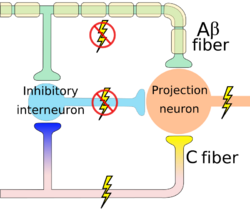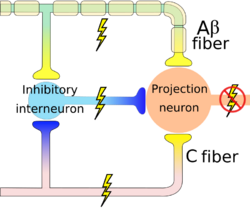Pain-Modulation
|
|
Original Editor - Your name will be added here if you created the original content for this page. Lead Editors |
This article or area is currently under construction and may only be partially complete. Please come back soon to see the finished work!
Pain Modulation[edit | edit source]
Pain modulation the process of alterations in the pain signals along the transmission pathway of pain, it explains why individuals response to the same stimulus different, explains the mechanism of action when using clinical analgesic. Pain control and modulation is a complex chore that is often the primary reason patients seek the services of rehabilitation professionals. Modulation of pain begins with an understanding of the various levels of pain modulation and extends to clinical interventions and protocols designed to reduce pain. For example, opiates they are capable of increasing and decreasing pain experience.
Levels of Pain Modulation[edit | edit source]
Pain modulation is easily classified into 5 discreet levels of interaction. These levels correspond to either important synaptic junctions, or significant chemical processes involved in the transmission of pain.
Level 1: Periphery[edit | edit source]
Level 1 pain modulation refers to events acting in the periphery of the body, at the source of the pain source. The somatosensation defined as the sensation from skin, mucus, limbs, and joints and classified into: thermoception, nociception, equilibrioception mechanoreception response to (vibration, touch, and pressure), and proprioception.
Nociceptors are peripheral cell nerve endings that initiate pain sensation, respond to noxious stimulus (thermal, mechanical, or chemical) which in turn trigger action potential to the spinal cord and to higher centers. It is divided into A delta and C fibers.
- A- delta fibers are large(larger than C- fiber) myelinated, fast conducting fibers, concerned with localized, sharp, and fast sensation of pain.
- C- fibers are small, unmyelinated, slow conducting nerve fibers, concerned with dull, and slow pain sensation.
Under normal conditions the nociceptors are inactive when there is a noxious stimulus (tissue damage) those pain receptors respond according to the stimulus type and cyclooxygenase-2 is activated to release more PG(prostaglandin) at the site of injury, and the nociceptors will transmit signals to the dorsal horn of spinal cord (first order neuron) where the firs neuron release chemical substance P to transmit signals..
A- beta are myelinated, large diameter, and have the fastest conduction velocity. These fibers respond to non painful stimulus such as touch sensation, mild pressure, and vibration. A beta stimulated by deep touch that explain why rubbing the painful site relief your pain.
Level 2: Dorsal Horn[edit | edit source]
Level 2 pain modulation refers to events in the dorsal horn of the spinal cord. The modulation at the level of spinal cord take place at Substantial Gelatenosa of Ronaldo SG under the theory of gait control theory GCT, it was proposed for first time in 1965 by Ronald Melzack and Patrick Wall, this theory explain pain transmission and modulation depending on large(A-Beta) and small (C-fibers) sensory fibers. At homeostasis conditions the gait is closed and no pain signals are transmitted (the inhibitory interneuron I block the projection neuron which transmit pain signals and connect to the brain).
When small nociceptors fibers are stimulated by noxious stimulus action potential signals are transmitted which in turn inhibit the inhibitory interneuron (I) and the projection neuron is activated the gate is opened and pain signal are transmitted to the brain. When action potential transmits through the first order neuron that in turn activate the vesicles to release the substance P which propagate the transmission of pain signals.
If large sensory fibers(A-Beta) activated by deep touch for example the transmitted signals activate the inhibitory interneuron and which blocks the projection neuron, the gate is close and no pain[1].
The modulation at the level of spinal cord produce localized analgesic effect and it receive another control from the descending pathway to cause diffuse inhibition of pain.
Level 3: Fast Neuronal Descending Pathways[edit | edit source]
The descending inhibitory pathway/ pain modulation mechanism depend on the release of opioids at the SG it controls/ inhibits signals transmission between the the 1st and 2nd order neuron. The descending pathway start from periaqueductal gray matter PAG in the midbrain, then to raphe nucleus in the medulla to the dorsal horn of spinal cord where:
These pathways release serotonin and noradrenergic neuron to inhibit the release of substance P from the presynaptic cleft of the first order neuron.
Stimulate the inhibitory interneuron to release opioids which in turn inhibit the presynaptic form releasing substance P and inhibit the post synapse of the second order neuron from transmitting signals.
Level 4: Hormonal[edit | edit source]
Level 5: Cortical[edit | edit source]
Pain Interventions[edit | edit source]
Modalities[edit | edit source]
Exercise[edit | edit source]
Manual Therapy[edit | edit source]
References[edit | edit source]
- ↑ Yam MF, Loh YC, Tan CS, Khadijah Adam S, Abdul Manan N, Basir R. General pathways of pain sensation and the major neurotransmitters involved in pain regulation. International journal of molecular sciences. 2018 Aug;19(8):2164.
- ↑ Armando Hasudungan. Introduction to Upper and Lower Motor Neuron Lesions . Available from: http://www.youtube.com/watch?v=ClXsS7O8seg[last accessed 11/12/2021]








